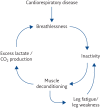Improving the quality of life of people with advanced respiratory disease and severe breathlessness
- PMID: 31508158
- PMCID: PMC6717608
- DOI: 10.1183/20734735.0200-2019
Improving the quality of life of people with advanced respiratory disease and severe breathlessness
Abstract
Advanced respiratory disease imposes a greater symptom burden than many cancers but not does have comparable recognition of the need for supportive and palliative care or the infrastructure for its systematic delivery. Consequently, many people with advanced respiratory disease (and those closest to them) have a poor quality of life, disabled by chronic breathlessness, fatigue and other symptoms. They are socially isolated by the consequences of long-term illness and are often financially impoverished. The past decade has seen an increasing realisation that care for this group must improve and that symptom management must be prioritised. Clinical guidelines recommend person-centred care, including access to supportive and palliative care as needed, as part of standard medical practice. Advanced lung disease clinics and specialist breathlessness services (pioneered within palliative care) are developing within respiratory medicine services but are provided inconsistently. This review covers the comprehensive assessment of the patient with advanced respiratory disease, the importance of supporting carers and the current best practice in the management of breathlessness, fatigue and cough. It also suggests ways to incorporate person-centred care into the general respiratory clinic, assisted by better liaison with specialist palliative and primary care. Emerging evidence shows that excellent symptom management leads to better clinical outcomes and reduces inappropriate use of emergency medical services.
Key points: People living with advanced respiratory disease and severe chronic breathlessness (and those closest to them) have a poor quality of life.Chronic breathlessness is a disabling symptom, and acute-on-chronic/episodic breathlessness is frightening to experience and observe.Chronic breathlessness imposes profound physical limitations and psychosocial burdens on those suffering from it or living with someone experiencing it.Fatigue and cough are two other cardinal symptoms of advanced respiratory disease, with very detrimental effects on quality of life.The impact of all these symptoms can be alleviated to a variable extent by a predominantly non-drug complex intervention.Many of the interventions are delivered primarily by allied health or nursing professionals.Doctors, nurses and other health professionals also need to play an active part in promoting quality of life as part of excellent medical care.A person-centred, psychologically informed approach is needed by all clinicians treating patients with advanced respiratory disease.
Educational aims: To give specialist respiratory clinicians practical clinical tools to help improve the quality of life of their patients with advanced respiratory disease and chronic breathlessness.To outline the evidence base for these interventions with reference to definitive sources.To highlight the importance of person-centred care in people with respiratory disease at all stages of illness.
Conflict of interest statement
Conflict of interest: S. Booth has nothing to disclose. Conflict of interest: M.J. Johnson reports institutional payment of honoraria from Novartis, and institutional payment for clinical consultancy from Mayne Pharma, outside the submitted work.
Figures






Similar articles
-
Provision of palliative care for people with chronic obstructive pulmonary disease: a narrative review.Ann Palliat Med. 2024 Jul;13(4):1012-1027. doi: 10.21037/apm-24-11. Epub 2024 Jun 17. Ann Palliat Med. 2024. PMID: 38902988 Review.
-
Holistic services for people with advanced disease and chronic or refractory breathlessness: a mixed-methods evidence synthesis.Southampton (UK): NIHR Journals Library; 2019 Jun. Southampton (UK): NIHR Journals Library; 2019 Jun. PMID: 31241880 Free Books & Documents. Review.
-
Promoting and supporting self-management for adults living in the community with physical chronic illness: A systematic review of the effectiveness and meaningfulness of the patient-practitioner encounter.JBI Libr Syst Rev. 2009;7(13):492-582. doi: 10.11124/01938924-200907130-00001. JBI Libr Syst Rev. 2009. PMID: 27819974
-
Right care, first time: a highly personalised and measurement-based care model to manage youth mental health.Med J Aust. 2019 Nov;211 Suppl 9:S3-S46. doi: 10.5694/mja2.50383. Med J Aust. 2019. PMID: 31679171
-
Breathlessness in cancer and chronic obstructive pulmonary disease: using a qualitative approach to describe the experience of patients and carers.Palliat Support Care. 2003 Dec;1(4):337-44. doi: 10.1017/s1478951503030499. Palliat Support Care. 2003. PMID: 16594223
Cited by
-
Proportion and risk factors for death by euthanasia in dogs in the UK.Sci Rep. 2021 May 4;11(1):9145. doi: 10.1038/s41598-021-88342-0. Sci Rep. 2021. PMID: 33947877 Free PMC article.
-
Management of musculoskeletal pain in patients with idiopathic pulmonary fibrosis: a review.Ups J Med Sci. 2022 Jul 11;127. doi: 10.48101/ujms.v127.8739. eCollection 2022. Ups J Med Sci. 2022. PMID: 35910492 Free PMC article. Review.
-
Improving medical outcomes in lupus: enhancing the effectiveness of the medical interview and improving patient support.Rheumatol Adv Pract. 2020 Nov 30;4(2):rkaa066. doi: 10.1093/rap/rkaa066. eCollection 2020. Rheumatol Adv Pract. 2020. PMID: 33376946 Free PMC article. No abstract available.
-
Supplementation of Vitamin D and Mental Health in Adults with Respiratory System Diseases: A Systematic Review of Randomized Controlled Trials.Nutrients. 2023 Feb 16;15(4):971. doi: 10.3390/nu15040971. Nutrients. 2023. PMID: 36839336 Free PMC article.
-
The Experiences and Perceptions of Telehealth in Patients Living With Advanced Chronic Obstructive Pulmonary Disease: A Qualitative Evidence Synthesis.J Adv Nurs. 2025 Apr;81(4):1700-1716. doi: 10.1111/jan.16493. Epub 2024 Oct 18. J Adv Nurs. 2025. PMID: 39420778 Free PMC article.
References
-
- Global Initiative for Chronic Obstructive Lung Disease (GOLD). Global Strategy for the Diagnosis, Management and Prevention of COPD. 2017. Available from: https://goldcopd.org - PubMed
-
- Wouters EFM, Augustin IML. COPD health-care delivery: a holistic and dynamic approach is needed. Lancet Respir Med 2016; 4: e30–e31. - PubMed
-
- Complexities of care in COPD. Lancet 2017; 389: 574. - PubMed
-
- Maddocks M, Lovell N, Booth S, et al. . Palliative care and management of troublesome symptoms for people with chronic obstructive pulmonary disease. Lancet 2017; 390: 988–1002. - PubMed
-
- World Health Organization. Chronic Respiratory Diseases. www.who.int/respiratory/en/
Publication types
LinkOut - more resources
Full Text Sources
Miscellaneous
